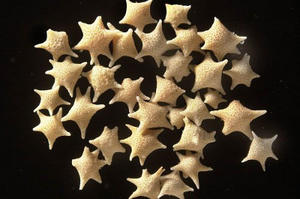Infrastructure protectionTiny organisms in oceans can save islands from rising sea levels: study
Warming climate is causing sea levels to rise, posing a special threat to low-lying island nations. The government of the Maldive Islands, an island nation in the Indian Ocean consisting of a chain of twenty-six atolls, has begun exploring the possibility of purchasing land in Africa to relocate the entire population – about 330,000 – once rising sea water begin to swallow the small atolls. Scientists found out, though, that the warming temperature of the seas is causing tiny single-cell organisms to are spreading rapidly through the world’s oceans, where they just might be able to mitigate the consequences of climate change.

Starsand foraminfera // Source: University of Bonn
The climate is getting warmer, and sea levels are rising — a threat to island nations. As a group of researchers lead by colleagues from the University of Bonn found out, at the same time, tiny single-cell organisms are spreading rapidly through the world’s oceans, where they might be able to mitigate the consequences of climate change. Foraminifera of the variety Amphistegina are stabilizing coastlines and reefs with their calcareous shells. The study’s results have now appeared in the international online journal PLOS ONE.
Countless billions of tiny, microscopic shelled creatures known as foraminifera inhabit the oceans of our planet: some of which look like little stars, others like Swiss cheese, and yet others like tiny mussels.
A University of Bonn release reports that they are extremely plentiful and exceptionally diverse in shape. Most of the approximately 10,000 foraminifera species live on the bottom of tropical and sub-tropical oceans, are surrounded by a calcareous shell, and do not even reach the size of a grain of sand. Yet, these tiny organisms are capable of enormous tasks. “Foraminifera are ecosystem engineers,” says Prof. Dr. Martin Langer from the Steinmann-Institut für Geologie, Mineralogie und Paläontologie at the University of Bonn. “With their shells, these protozoa produce up to two kilograms of calcium carbonate per square meter of ocean floor. This often makes them, after corals, the most important producers of sediment in tropical reef areas.”
About 9,000 kilometers along the coast
Together with their colleagues from the Zoologisches Forschungsmuseum Alexander Koenig, the University of Trier, and the Woods Hole Oceanographic Institution in the United States, the scientists from the University of Bonn studied the range of Amphisteginid foraminifera. Amphisteginids are among the most conspicuous and ubiquitous foraminifera on coral reefs and tropical carbonate environments and often have been referred to as living sands. Over the past years, Prof. Langer has been capturing the range in which Amphisteginids occur along the about 9,000 kilometer-long coastline off Somalia, Kenya, Tanzania, Mozambique, South Africa, Namibia, and Angola. “The range of Amphistegina is essentially governed by ocean temperature and nutrient content of the waters,” the micro-paleontologist explains. So, for example, these protozoa need a water temperature of at least 14 degrees Celsius.
By 2100, the protozoa will have spread almost 300 kilometers closer to the poles
Using the data from biogeographic terrain analyses, the researchers developed a species distribution model for calculating where Amphisteginid foraminifera occur under certain environmental
